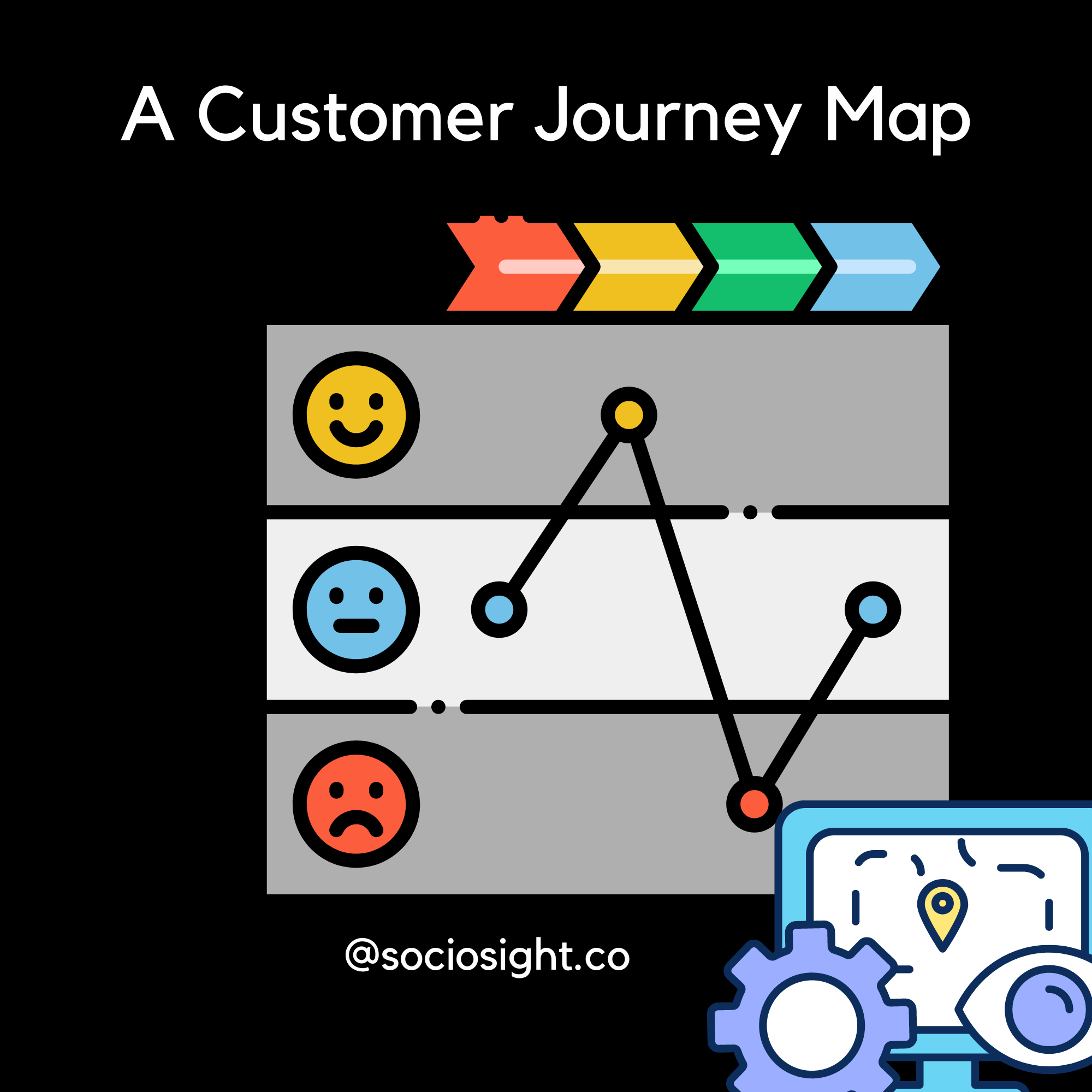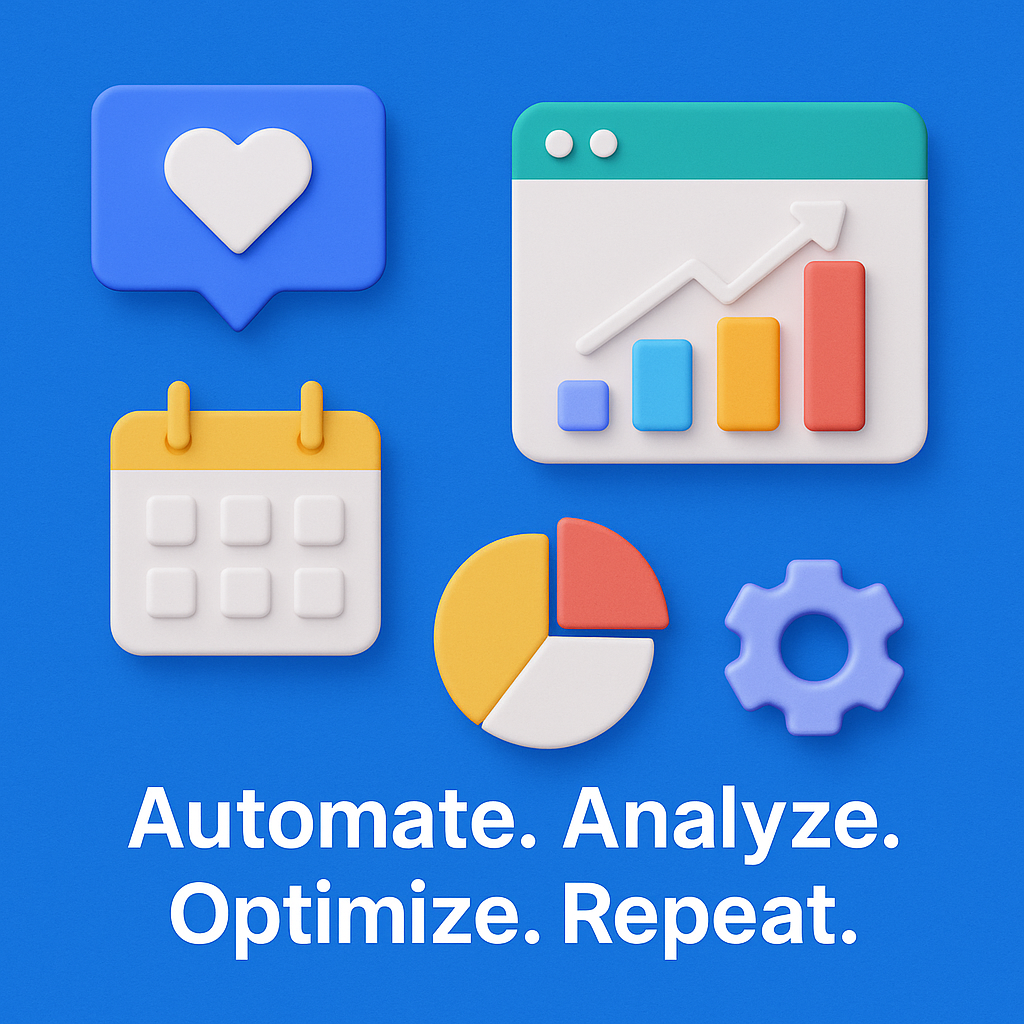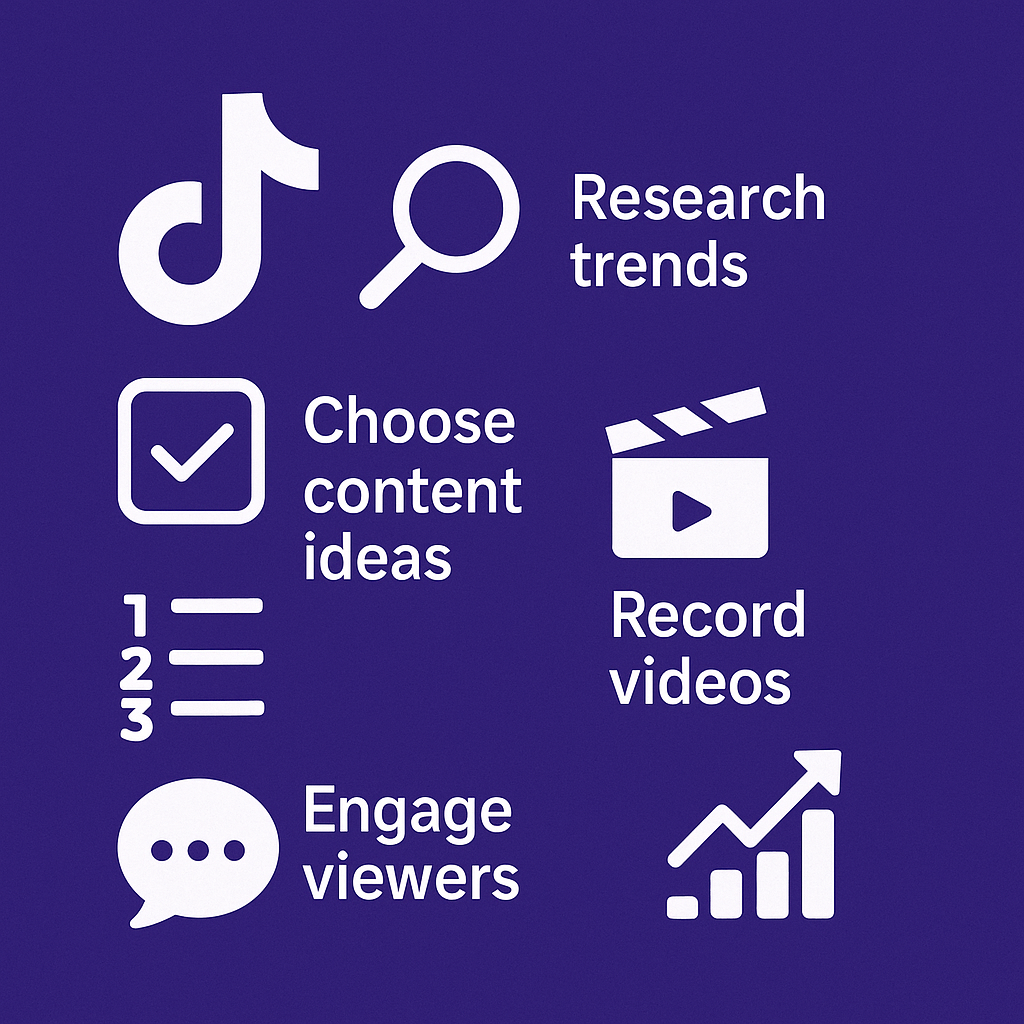As a small business owner, you’re probably aware of the challenges of acquiring and retaining customers, and this is where understanding the customer journey maps becomes essential.
The customer journey is the entire process your customers go through while interacting with your brand, from the moment they become aware of your products or services until they become loyal, satisfied customers and even advocates for your brand.
You will need a customer journey map to create a seamless customer experience.
A customer journey map is a powerful tool that can help you visualize and analyze this journey.
By creating a comprehensive map of your customer’s experience, you can uncover pain points, identify opportunities for improvement, and tailor your marketing strategies to better meet your customers’ needs. This map, in turn, can lead to higher customer satisfaction, stronger brand loyalty, and, ultimately, increased revenue for your small business.
So, what are you waiting for?
It’s time to dive into the world of customer journey mapping and unlock the potential for growth and success in your small business.
Keep reading to discover the key differences between customer journeys and marketing funnels, why you need a journey map, and how to create one that works for your business.
Table of Contents
Demystifying the Differences: Customer Journey vs. Marketing Funnel
As a small business owner, you may have encountered the terms “customer journey” and “marketing funnel” and wondered about their differences. While both concepts aim to understand and improve customer interactions, they have distinct characteristics and serve different purposes.
The journey outlines the steps your customers take to become customers, from initial discovery to repeat purchases. It tells a story about how customers interact with your brand and lays out various touchpoints that customers might encounter. Not every customer will engage with all of these touchpoints, but understanding the overall journey helps you provide a smooth experience for your audience.
Do you struggle with managing multiple social media platforms for your brand's presence?
The Sociosight app can help you simplify the process and save you time. With Sociosight, you can publish, schedule, and monitor posts and engage with your followers across multiple social media platforms, all from one dashboard.
Get started today with a free sign-up!
Register Now for Free

On the other hand, a marketing funnel is a model that helps you market your products and services to customers based on where they are in their customer journey. It’s often divided into awareness, consideration, and conversion stages. The marketing funnel’s primary goal is to move customers from one step to the next, ultimately leading to a sale. It works with the customer journey but focuses on marketing to guide customers toward a conversion.
What is Customer Journey Map?
A customer journey map is a visual representation of the entire experience your customers have with your brand, from the initial discovery stage to repeat purchases and brand advocacy. It’s a powerful tool that helps you better understand your customers’ needs, expectations, and pain points at every step of their journey.
By illustrating the different touchpoints and interactions your customers have with your business, a customer journey map provides valuable insights into your customers’ thoughts, emotions, and behaviors. This comprehensive overview enables you to identify areas for improvement, tailor your marketing strategies, and create more meaningful, seamless experiences that resonate with your target audience.
The Importance of Customer Journey Maps: Why Your Business Needs Them
As a small business owner, you might wonder why a customer journey map is crucial for success.
Here are some key reasons why investing time and effort into creating a customer journey map can significantly benefit your business:
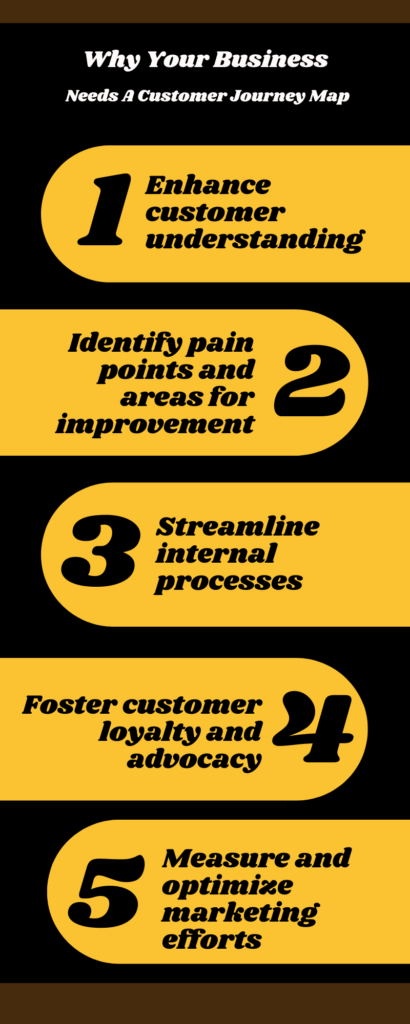
- Enhance customer understanding: A customer journey map helps you dive deeper into your customers’ thoughts, emotions, and behaviors. Understanding their needs and expectations at each touchpoint allows you to create personalized and targeted marketing strategies that resonate with your audience and drive customer satisfaction.
- Identify pain points and areas for improvement: Mapping the customer journey allows you to pinpoint potential friction or dissatisfaction points in your customers’ experiences. Addressing these issues can create a smoother and more enjoyable customer journey, increasing the likelihood of repeat purchases and brand loyalty.
- Streamline internal processes: A comprehensive customer journey map provides your team with a clear understanding of each customer interaction, helping to align departments, set goals, and optimize operations. This results in a more cohesive and efficient approach to serving customers and achieving business objectives.
- Foster customer loyalty and advocacy: By creating meaningful and seamless customer experiences, you’re more likely to build strong relationships and foster loyalty. Satisfied customers are more likely to advocate for your brand, providing valuable word-of-mouth marketing and driving new business.
- Measure and optimize marketing efforts: Customer journey maps enable you to track the effectiveness of your marketing strategies and make data-driven decisions. By analyzing the performance of each touchpoint, you can identify which tactics work best and optimize your marketing efforts for maximum impact.
In summary, a well-designed customer journey map is a powerful tool that can help you better understand your customers, improve their experiences, and, ultimately, grow your small business.
Now, let’s learn how to build a practical customer journey map that sets your business up for success.
Step-by-Step Guide: How to Build an Effective Customer Journey Map
Creating a customer journey map can seem daunting, but with the right approach and a step-by-step plan, you can build a practical map that sets your business up for success.
Steps to Create a Customer Journey Map
Here’s a guide to help you through the process:
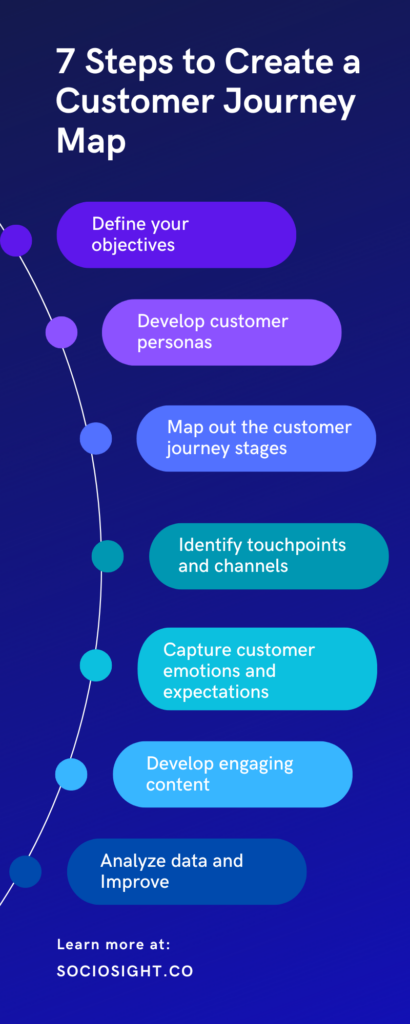
Step-1: Define your goals.
Start by determining the goals you want to achieve with your customer journey map. Are you looking to improve customer satisfaction, boost conversions, or streamline internal processes? Clear objectives will help guide your mapping process and ensure it aligns with your business goals.
Step-2: Develop customer personas.
Understand your target audience by creating detailed customer personas representing your ideal customers. Gather information about their demographics, motivations, preferences, and pain points. These personas will help you tailor your customer journey map to the specific needs of your audience.
Step-3: Map out the customer journey stages.
Break down the journey on each phase of marketing funnel as per your goal in this customer journey map. The funnels could include awareness, consideration, decision, retention, and advocacy. These stages will help you visualize the customer experience and identify key touchpoints and interactions.
Step-4: Identify touchpoints and channels.
You can list all the touchpoints and tracks where customers interact with your brand throughout their journey. These touchpoints may include your website, social media platforms, email marketing, customer support, or in-store experiences. Be thorough and have every possible point of interaction.
Step-5: Capture customer emotions and expectations.
Try understanding your customers’ emotions, expectations, and potential pain points for each touchpoint. Doing so will help you identify areas for improvement and enhance their overall experience.
Step-6: Develop engaging content.
Create tailored content to connect with your customers at each touchpoint. Use a content batching strategy to maintain a consistent brand voice, keep your customer personas in mind, and utilize proven copywriting formulas like AIDA copywriting or FAB copywriting to drive customer action.
Step-7: Analyze data and Improve.
Use available data and analytics tools to gain insights into customer behavior, preferences, and feedback at each touchpoint. This information will help you understand what’s working, what’s not, and where opportunities for improvement lie.
Based on your analysis, pinpoint areas where you can enhance the customer experience, remove friction points, or better meet customer expectations. Prioritize these opportunities based on their potential impact on your business goals.
Make the necessary improvements and track the results over time. Monitor key performance indicators (KPIs) related to your objectives, such as customer satisfaction scores, conversion rates, or customer retention. Continuously optimize your customer journey map based on the data and insights you gather.
Remember, customer journey mapping is an ongoing process. Regularly review and update your map to ensure it remains relevant and accurately reflects your customers’ evolving needs and expectations. By following this step-by-step guide, you’ll be well on your way to creating a practical customer journey map that drives growth and success for your small business.
A Case Study of Customer Journey Map
Let’s take a look at one of customer journey examples below to help you visualize a customer journey map through a practical case study of a small online fitness equipment store called “Fit Gear Hub.”
Step 1: Define your objectives.
One of Fit Gear Hub’s customer journey map objectives is to increase website traffic by 20% within the next six months.
Step 2: Develop customer personas.
Fit Gear Hub identifies two primary customer personas: “Workout Warrior Wendy,” a fitness enthusiast who values high-quality, durable equipment, and “Busy Parent Paul,” who seeks convenient home workout solutions.
Step-3 Map out the customer journey stages
Since the primary objective is to increase website traffic, Fit Gear Hub should focus on the awareness and consideration stages of the customer journey.
Step-4 Identify touchpoints and channels
Fit Gear Hub needs to identify the most influential touchpoints and channels to drive website traffic. These may include:
Awareness:
- Social media ads (Facebook, Instagram, Pinterest, etc.)
- Influencer partnerships
- Blog posts
- Search engine optimization (SEO)
- Podcast sponsorships
- YouTube collaborations
- Content partnerships with other fitness websites and blogs
Consideration:
- Email newsletters
- Remarketing ads
- Social media posts and stories
- Collaborative webinars or virtual events
- Downloadable resources, such as workout plans or e-books
- Online community engagement (e.g., fitness forums, Facebook groups)
Step-5 Capture customer emotions and expectations
Fit Gear Hub should analyze customer emotions and expectations at each touchpoint during the awareness and consideration stages.
For example, during the awareness stage:
- Social media ads: Potential customers might feel curious about the brand, intrigued by the ad visuals, or interested in learning more about the products.
- Influencer partnerships: Customers might trust the influencer, be inspired by their fitness journey, or be motivated to try the recommended products.
- Blog posts: Readers could feel informed by the content, grateful for helpful tips, or more confident in their ability to make fitness-related decisions.
During the consideration stage:
- Email newsletters: Subscribers may feel excited by the prospect of exclusive offers or special promotions, reassured by testimonials from other customers, or informed about new products and features.
- Remarketing ads: Potential customers might feel a sense of urgency to make a purchase, be reminded of their initial interest, or be intrigued by the personalized content of the ads.
- Social media posts and stories: Followers may feel connected to the brand, engaged by the community, or inspired by the shared fitness journeys of other customers.
By analyzing and understanding the emotions and expectations of customers at these touchpoints, Fit Gear Hub can tailor its content and marketing strategies to create a more compelling customer journey map focused on increasing website traffic.
Step-6 Develop engaging content
Create tailored content that appeals to Workout Warrior Wendy and Busy Parent Paul, addressing their needs, preferences, and pain points. Ensure that the content is shareable, valuable, and engaging to drive traffic to the website.
And to reach its target audience effectively and drive website traffic, Fit Gear Hub should employ a multi-channel marketing approach. This approach may involve using organic and paid strategies across different platforms, such as social media, search engines, and content marketing.
Fit Gear Hub should select which social media will use to reach its target audience when driving website traffic from social media. It doesn’t have to be active on every social media, but it should be active on social media where most of its target audience hangs out.
Since its target audience in marketing could be more than one social media platform, it’s essential to have an effective social media management strategy, including using a social media scheduling tool like the Sociosight App. This tool will enable Fit Gear Hub to plan, schedule, and post content simultaneously on multiple platforms, streamlining your social media efforts and maximizing its reach.
Step-7 Analyze Data and Improve
Fit Gear Hub should ensure they have tracking and analytics tools like Google Analytics to monitor website traffic, user behavior, and engagement. This tool will help them measure the success of their strategies and identify areas for optimization.
Regularly review the data and insights from the tracking and analytics tools. Use this information to understand which strategies drive the most traffic and adjust the customer journey map accordingly.
Based on the data and insights collected, Fit Gear Hub should continuously optimize its strategies to improve website traffic. This strategy may involve adjusting their content, targeting, ad spending, or channels based on what’s driving the best results.
Leveraging Technology: Tips for Automating the Customer Journey Mapping Process
In today’s fast-paced digital world, small businesses must use technology to streamline processes and stay ahead of the competition.
Automating the customer journey mapping process can save you time, increase efficiency, and help you create more personalized and targeted marketing campaigns.
Here are some tips to help you leverage technology in your customer journey mapping efforts:
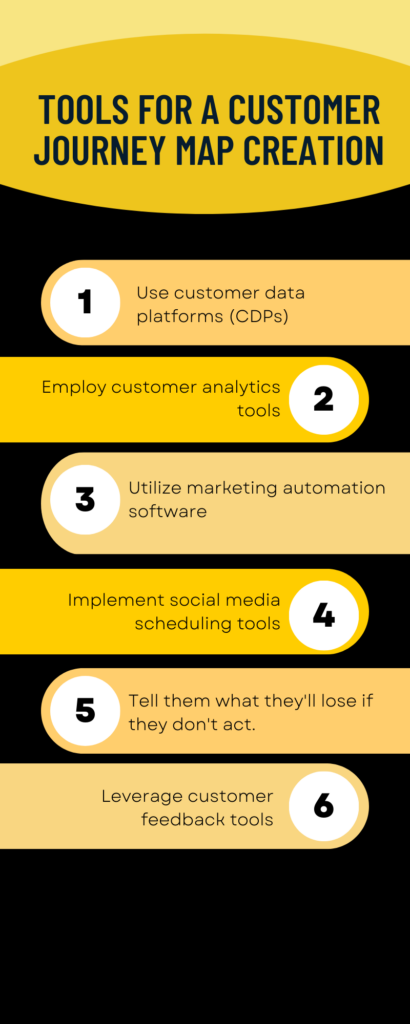
- Use customer data platforms (CDPs): A CDP can help you centralize and organize customer data from multiple sources, such as social media, email marketing, and website analytics. This CDP will enable you to gain valuable insights into customer behavior and preferences, which can inform your customer journey mapping process.
- Employ customer analytics tools: Customer analytics tools can help you analyze your customer data to identify trends, patterns, and opportunities for improvement. These insights can refine your customer journey map and create more targeted marketing strategies.
- Utilize marketing automation software: Marketing automation software can help you automate many aspects of your marketing campaigns, from email marketing and social media management to lead nurturing and conversion tracking. By automating these processes, you can ensure that your marketing efforts are consistent and efficient, freeing up more time to focus on refining your customer journey map.
- Implement social media scheduling tools: As mentioned earlier, tools like the Sociosight App can help you manage your social media presence by allowing you to plan, schedule, and post content across multiple platforms. These tools will enable you to save time and ensure your social media content aligns with your customer journey map.
- Leverage customer feedback tools: Gathering customer feedback is crucial for understanding how customers feel at each journey stage. Tools like online surveys, feedback forms, or live chat can help you collect valuable insights from your customers, which can then be used to refine your customer journey map.
- Integrate CRM systems: Customer relationship management (CRM) techniques can help you keep track of your customer interactions and provide a comprehensive view of your customer’s needs, preferences, and behaviors. Integrating your CRM system with your customer journey mapping process can create a more personalized and targeted customer experience.
By leveraging these technologies and tools, small business owners like you can automate the customer journey mapping process, making it more efficient and effective. This strategy will help you better understand your customers, create more targeted marketing campaigns, and ultimately drive growth for your business.
Key Takeaways: Implementing Customer Journey Maps for a Thriving Business
In conclusion, customer journey maps are essential for small business owners looking to understand their customers better and create more targeted and effective marketing campaigns.
By implementing customer journey maps, you can gain valuable insights into your customers’ needs, preferences, and emotions, which can help you drive growth and success for your business.
Here are some key takeaways to remember when implementing customer journey maps:
- Understand the difference between customer journeys and marketing funnels: While the customer journey focuses on the customer’s entire experience with your brand, the marketing funnel is a tool that helps you target your marketing efforts based on where customers are in their journey.
- Create detailed customer personas: Crafting well-defined customer personas will help you better understand your target audience and create a more personalized customer experience.
- Map out the customer journey stages: Identify the steps in the customer journey, from awareness to advocacy, and focus on the customer journey touchpoints and channels that are most relevant to your business goals.
- Capture customer emotions and expectations: Understanding the feelings and expectations of your customers at each touchpoint can help you create more engaging and targeted content.
- Leverage technology to automate and streamline the customer journey mapping process: Utilize customer data platforms, analytics tools, marketing automation software, social media scheduling tools, feedback tools, and CRM systems to save time and increase efficiency.
- Continuously analyze and optimize your customer journey map: Regularly review your customer journey map and make adjustments based on data, insights, and customer feedback to ensure that your marketing efforts remain practical and relevant.
By considering these key points and implementing a well-crafted customer journey map, you can better understand your customers, create more effective marketing campaigns, and ultimately set their businesses up for success.
So, are you ready to create a customer journey map for your business? Share your thoughts @sociosight.co.




